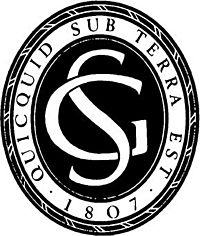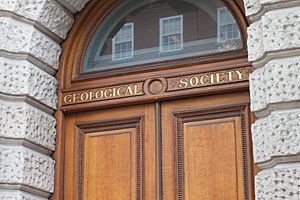Geological Society of London facts for kids
 |
|
| Formation | 13 November 1807 |
|---|---|
| Founded at | Freemasons Tavern, Great Queen Street London, WC2 |
| Type | Learned society |
| Registration no. | 210161 |
| Headquarters | Burlington House, Piccadilly London, W1 |
|
Membership
|
12,000 |

The Geological Society of London is a group in the United Kingdom for people who study geology. It is often called the Geological Society. It is the oldest group of its kind in the world. It is also the biggest in Europe, with over 12,000 members.
Members of the Society are called "Fellows". They can use the letters FGS after their names. More than 2,000 Fellows are also "Chartered Geologists". This means they are recognized as professional geologists.
The Society is a registered charity. This means it works for public benefit and not for profit. It helps geologists meet each other. It also helps them share new discoveries. The Society wants to find out what is known in geology and what still needs to be found.
Contents
History of the Geological Society
The Geological Society started on November 13, 1807. It began at the Freemasons' Tavern in London. Thirteen people founded the Society. These included famous scientists like Humphry Davy.
The Society received a special approval from King George IV in 1825. This approval is called a royal charter. Since 1874, the Society has been based at Burlington House in London. This building has a huge library. It holds over 300,000 books and journals about geology.
For a long time, only men could be Fellows. But in 1919, women were finally allowed to join. In 1991, the Society joined with another group. This group was called the Institution of Geologists. The Institution had been formed to support professional geologists.
The Society is also part of the European Federation of Geologists. In 2007, the Society celebrated its 200th birthday. They held many events about earth sciences.
Special Interest Groups
The Society has many groups for different interests. There are 24 specialist groups. There are also 15 regional groups. These groups allow members to meet and talk about specific topics or areas. Joining these groups is free for members. Some groups are also open to people who are not members.
The Regional Groups are:
- Central Scotland
- East Anglian
- East Midlands
- Home Counties North
- Hong Kong
- North West
- Northern
- Northern Ireland
- Solent
- South East
- South West
- Southern Wales
- Thames Valley
- West Midlands
- Western
- Yorkshire
The Specialist Groups are:
- British Geophysical Association
- British Sedimentological Research Group
- British Society for Geomorphology
- Contaminated Land Group
- Earth Systems Science Group
- Energy Group
- Engineering Group
- Forensic Geoscience Group
- Geochemistry Group
- Geological Curators' Group
- Geological Society Business Forum
- Geological Society Discussion Group
- Geological Remote Sensing Group
- Geoscience Information Group
- History of Geology Group
- Hydrogeological Group
- Marine Studies Group
- Metamorphic Studies Group
- Mineral Deposits Studies Group
- Near Surface Geophysics Group
- Quaternary Research Association
- Tectonic Studies Group
- Volcanic & Magmatic Studies Group
Famous Past Presidents
Many well-known geologists have led the Society. These include early geology experts. Some famous names are William Buckland, Charles Lyell, and Thomas Henry Huxley. Later leaders include Janet Watson.
Awards and Funds
The Society gives out important awards for geology. In 1831, they started the Wollaston Medal. This is their top award. In 2006, it was given to James Lovelock. He created the Gaia hypothesis.
Medals Given by the Society
- Aberconway Medal
- Bigsby Medal
- Dewey Medal
- Distinguished Service Award
- Lyell Medal
- Major John Sacheverell A'Deane Coke Medal
- Major Edward D'Ewes Fitzgerald Coke Medal
- Murchison Medal
- President's Awards
- Prestwich Medal
- R. H. Worth Award
- Sue Tyler Friedman Medal
- William Smith Medal
- Wollaston Medal
Funds Managed by the Society
The Society also manages special funds. These funds help support geology research.
- Lyell Fund
- Murchison Fund
- Wollaston Fund
- William Smith Fund
See also
 In Spanish: Sociedad Geológica de Londres para niños
In Spanish: Sociedad Geológica de Londres para niños
- Geology of Great Britain
- Journal of the Geological Society
- William Smith (geologist)

